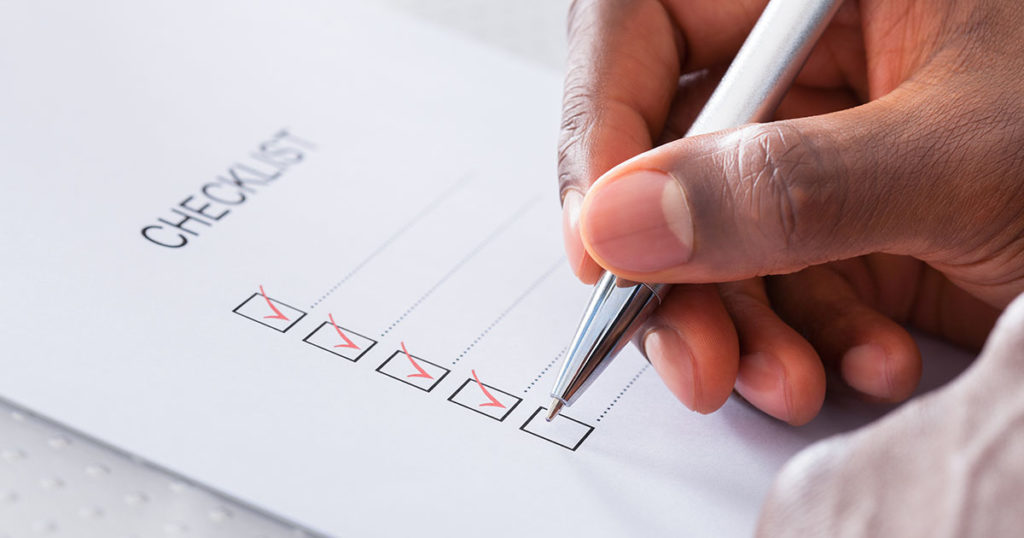
Not sure how to go about hiring a new tradesperson?
Firstly, congratulations! Bringing on new members of staff is a huge milestone for any business! Whether you’re hiring your first employee or your seventeenth, here are a few tips that will make sure you’ve set everything up correctly and legally from the off.
In this article, we will cover:- Our 9-point checklist to guide you through the process
- Responsibilities under the Health and Safety at Work Act (HSWA)
- A written statement of employment
- Registering with the HMRC
- Pay and other costs
- Pensions
- Understand the rights of your staff
- Questions about employing tradespeople for the first time
Use our 9-point checklist to guide you through the process.

We’ll discuss the legal right to work in the UK, DBS Checks, Employers Liability Insurance, Employment Contracts, HMRC obligations, paying staff, and employment rights. All the boring stuff, we know, but getting it wrong can put you out of business, so it’s worth a read…
1. Legal Right to work in the UK
Before someone starts work, you’ll need to check if they have the legal right to work in the UK, otherwise, you could be liable to a fine of up to £20,000! It’s really easy to do, just:
- Obtain ID: ask to see the new employee’s original documents. Ask for a passport or driving licence if they’re a UK resident, or an immigration document or a certificate of permanent residence if they’re not.
- Check the documents are real: look for inconsistencies in photographs, expiry dates, restrictions on work, different names due to marriage, divorce or deed poll (keep proof of those documents too).
- Copy both sides of the documents for your records (just the photo page for passports) and keep the copies for at least two years after the employment has come to an end. It’s best to take note of the date you checked too – especially if they need to be renewed.
2. DBS Checks
If you work in a field that requires one, you might need to apply for a DBS check (previously known as a CRB check) for the new employee.
3. Employment Liability Insurance
You’ll need employers’ liability insurance as soon as you become an employer.
Without it, you risk facing fines of around £2,500 per day. Ouch!
Employers’ liability (EL) protects your business if it is sued (taken to court) by an employee who suffers injury or illness at work. A broker will be able to advise on the level of cover you need. Be sure to display the certificate in your workplace.
4. Health and Safety at Work Act (HSWA)
In the construction industry 36 workers and five members of the public die each year; 49% of those deaths are due to falls from height.1
The HSWA aims to protect people from the risk of injury or ill health at work by ensuring employees’ health, safety, and welfare at work, protecting non-employees against the health and safety risks arising from work activities, and controlling the keeping and use of explosive or highly flammable or dangerous substances. You can find more information from the Health and Safety Executive website.
No one even needs to be injured for you to be breaking the law! Just exposing employees to risk could see you held liable! So, make sure you have followed the checklist and keep training records for all employees.
- Have you provided staff with safety equipment and safe systems of work?
- Is your equipment properly maintained?
- Are materials properly stored, handled, used and transported?
- Have you provided sufficient instruction, supervision, and training to allow staff to undertake their role safely?
- Do you have a written Health & Safety Policy?
- Have you conducted a risk assessment to identify and control potential causes of harm within the workplace?
Top tip: To avoid any accidents, make sure that your working environment is clean, tidy and safe. Safe working practices, such as training on using the equipment, working at height, safe equipment and PPE are just the basics! Each trade has specific regulations they need to follow, so be aware of them and make sure you have adequate health and safety training for your staff too.
5. A written statement of employment

An employment contract doesn’t have to be written down to be legally valid. Still, employees are legally entitled to aWritten Statement of the main terms and conditions of their employment within two months of starting their job (if the job lasts for more than 1 month). Whatever you do, don’t forget.
A written statement of employment must include at least:
- The business’ name
- The employee’s name, job title or a description of work and start date
- If a previous job counts towards a period of continuous employment, the date the period started (only applies if worked within a company group)
- How much and how often the employee will get paid
- Hours of work (and if employees will have to work Sundays, nights or overtime)
- Holiday entitlement (and if that includes public holidays)
- Where the employee will be working and whether they might have to relocate
- If an employee works in different places, where they will be and what the employer’s address is
- How long a temporary job is expected to last
- The end date of a fixed-term contract
- Notice periods
- Collective agreements
- Pensions
- Who to go to with a grievance (a grievance is an issue at work)
- How a grievance is handled
- How to complain about a disciplinary or dismissal decision
6. Registering with the HMRC
To stay on the right side of the taxman, you’ll need:
- To register as an employer with the HM Revenue and Customs (HMRC);
- To take into account any Student Loans and National Insurance before starting to register your new employee; and
- A P45 from their previous employer, if possible.
You can do this up to 30 days after you pay your new staff but don’t miss the deadline as you could incur a fine!
Be sure to log in to HM Revenue and Customs’ (HMRC) PAYE Online service to:
- Send payroll reports to HMRC
- Access tax codes and notices about your employees
- Appeal a penalty (if you ever get one)
- Get alerts from HMRC if you are late reporting or paying or send in the wrong monthly reports.
Tax Records have to be kept for six years so keep them safe and easily accessible. Your accounting software should be able to do this for you. It should also help you monitor the financial and tax status of your business. For example, by keeping track of ‘deductible expenses,’ which are business expenses that can be claimed to reduce your overall tax bill. Cha-Ching!
7. Pay and other costs
Every time you pay your employees, you’ll need to use payroll software to:
- Record their pay – include their salary or wages and any additional pay. Remember you’ll need to pay your employee at least the National Minimum Wage which is different for apprentices.
- Calculate deductions from their pay, like tax and National Insurance.
- Calculate the employer’s National Insurance contribution, which is 12% of earnings above the government defined threshold (at the time of writing).
- Produce payslips for each employee (you can use different software if your payroll software does not have this feature).
- Report their pay and deductions to HMRC in a Full Payment Submission (FPS).
- Pay Statutory Sick Pay if the employee is off sick, they are entitled to £94.25 per week for up to 28 weeks (at the time of writing).
There are loads of payroll systems available. If you don’t yet have one, contact a few to ask for a demo to see which one you find the easiest to use. Accountants seem to love Xero – it’s accounting software that includes payroll facilities!
8. Pensions
Be sure to enrol employees on and make an employer’s pension contributions for all staff who:
- Are aged between 22 and the State Pension age;
- Earn at least £10,000 a year; and
- Who normally work in the UK (this includes people who are based in the UK but travel abroad for work).
See the .gov website for more guidance on this and to check if you need to automatically enrol your staff into a workplace pension scheme.
9. Understanding employment rights

All employees have rights that are legally protected. There are two main types of employee rights: statutory (given by law) and contractual (given by a specific employment contract). If their rights are not met, they can seek compensation, but not everyone that works for you is classed as an employee. Different types of workers have different rights.
There are 3 main types of ‘employment status’ under the law; employee, worker or self-employed.
‘Employment status’ can be determined by:
- The type of employment contract someone has
- The way they get paid
- Who is responsible for paying their tax
- Their rights and responsibilities and those of the employer
Both employers and the people doing work for them need to know their rights and responsibilities, so it’s important to be sure of employment status.
Employee
Someone is generally classed as an employee if they:
- Have an employment contract from their employer, formed when they accept the job,
- Tend to be provided regular work by their employer,
- They are employed to do the work personally and they must do the work.
An employee has the rights to:
- A written statement of employment outlining their job rights and responsibilities, as a minimum
- Sick pay
- 28 days holiday pay
- Paid parental leave including maternity/paternity/shared parental leave or adoption leave
- Payslips
- Protection against unlawful discrimination and ‘whistleblowing’
- Not being treated less favourably if you work part-time
- Being able to claim redundancy and unfair dismissal after 2 years’ service
Worker
If the employment is more casual, someone could be classed as a worker. A worker will usually have a written or verbal ‘contract for services’ but they have very little obligation to receive or do work, though should do work that they’ve agreed to.
A worker has rights to:
- National Minimum Wage
- Paid holiday
- Payslips
- Protection against unlawful discrimination
- Protection for ‘whistleblowing’,
- Not being treated less favourably if they work part time.
Who can be classed as a worker? Zero hours – ‘as and when’ workers or temporary staff can fall under this category.
Self-employed
Someone is usually classed as self-employed if they are responsible for how and when they work. Self-employed people have some employment rights, including protection for health and safety on a client’s premises and protection against discrimination.
Who can be classed as self-employed? A tradesperson if they are the owner of a company, invoice for their pay, can work for different clients and charge different fees, can send someone else to do the work for them, and do not get paid holiday or sick leave.
Contractors and freelancers
Someone who is self-employed and gets work through an agency might be given a contract for services and be called a contractor. In this case, they might have a ‘worker’ employment status and rights for the duration of the contract, so it’s a good idea to check.
Learn more about employment status on the government website. Whether someone is classed as self-employed or a worker can affect how they pay tax, so always check theirtax status.
Hiring your first employee should be an exciting time, where your business takes its first big step. But if you make a mistake with the law you could risk losing your employees, your reputation and even your business. Use this checklist as an easy reminder to help protect your business from fines, claims and unnecessary costs to ensure that process is pain free and your new employee gets off with a flying start.
Questions about employing tradespeople for the first time
Find out whether the employee has the legal right to work in the UK and whether they need a DBS check. You’ll need to get Employers Liability Insurance. Make sure you know your employment contract obligations, your HMRC obligations, and how to pay staff and employers’ tax correctly. You should also know which employment rights you should be aware of.
Obtain their original ID documents, check they are real, take a copy of both sides for your records and keep them two years after the employment has come to an end. If they aren’t a UK citizen, then you’ll need to see the documents that allow them to work in the UK. Learn more above.
You might need to apply for a DBS check (previously known as a CRB check) for the new employee.
You’ll need employers’ liability insurance as soon as you become an employer. Otherwise you risk facing fines of around £2,500 per day.
Different trades have different duties depending on the work that you do. Training and monitoring staff on working practices is vital. The Health and Safety at Work Act will guide you. Use this checklist to help you think about the risks to your staff and the things you have implemented to minimise that risk:
– Have you provided staff with safety equipment and safe systems of work?
– Is equipment properly maintained?
– Are materials properly stored, handled, used and transported?
– Have you provided sufficient instruction, supervision and training to allow staff to undertake their role safely?
– Do you have a written Health & Safety Policy?
– Have you conducted a risk assessment to identify and control potential causes of harm within the workplace?
Make sure that your working environment is clean, tidy and safe. Safe working practices such as training on using equipment, working at height, safe equipment and PPE are just the basics! Use our health and safety checklist above to help you avoid accidents.
In short, no. An employment contract doesn’t have to be written down, but you do have to give employees a Written Statement5 of the main terms and conditions of their employment within two months of starting their job (if the job lasts for more than 1 month).
A written document detailing the main terms of employment. The document should include: the business’s name, the employee’s name, job description, start date, how much and how often an employee will get paid, hours of work, work location, finish date if temporary, notice periods, details of any collective agreements, pension details, who to go to with a grievance (an issue at work) and how it will be handled, and how to complain about a disciplinary or dismissal decision.
You’ll need to register with the HMRC as an employer no later than 30 days after you pay your new staff, but don’t miss the deadline as you could incur a fine!
Six years, so keep them safe and easily accessible.
Each time you pay your staff use payroll software to: record their pay, calculate tax and NI deductions from their pay, calculate the employers’ National Insurance contribution, produce payslips, report their pay and deductions to HMRC in a Full Payment Submission (FPS).
There are loads of payroll systems available if you don’t yet have one, so ask for a demo of a few of them to see which one you find the easiest to use, but an accountant can help you with these tasks. Accountants seem to love Xero!
You’ll need to enrol your staff into a pension and make an employer’s contribution for all staff aged between 22 and the state pension age, earn at least £10,000 a year, and work in the UK. For more guidance on this check if you need to automatically enrol your staff into a workplace pension scheme.
All employees have rights that are legally protected. There are two main types of employee rights: statutory (given by law) and contractual (given by a specific employment contract). They can seek compensation if their rights are not met but not everyone that works for you is classed as an employee. Different types of workers have different rights.
There are three main types of ‘employment status’ under the law; employee, worker and self-employed.
‘Employment status’ can be determined by the type of employment contract someone has, the way they get paid, who is responsible for paying their tax, their rights and responsibilities, and those of the employer.
Rights to a written statement of employment outlining their job rights and responsibilities, sick pay, holiday pay, parental leave pay and payslips. They also have protection against unlawful discrimination, ‘whistleblowing,’ not being treated less favourably if you work part time, and are able to claim redundancy and unfair dismissal after 2 years’ service.
Someone is classed as an employee if they: have an employment contract from their employer formed when they accept the job; tend to be provided regular work by their employer, are employed to do the work personally, and must do the work.
If the employment is more casual, someone could be classed as a worker. A worker will usually have a written or verbal ‘contract for services’ to do the work, but they have very little obligation to receive or do work, though should do work that they’ve agreed to. Zero hours – ‘as and when’ workers or temporary staff can fall under this category.
A worker has rights to the National Minimum Wage, paid holiday, payslips, protection against unlawful discrimination, protection for ‘whistleblowing’, and to not being treated less favourably if they work part time.
Someone is usually classed as self-employed if they are responsible for how and when they work. A tradesperson, if they are the owner of a company, invoice for their pay, can work for different clients and charge different fees, can send someone else to do the work for them, and do not get paid holiday or sick leave.
Protection for your health and safety on a client’s premises and protection against discrimination.
Someone who is self-employed and gets work through an agency might be given a contract for services and be called a contractor. In this case, they might have a ‘worker’ employment status and rights for the duration of the contract, so it’s a good idea to check.
Whether someone is classed as self-employed or a worker can affect how they pay tax, so always check their tax status.

